
The walls of the Athletes First offices are filled with autographed jerseys, photos and other memorabilia from their National Football League clients, including such household names as Aaron Rodgers, Ray Lewis, Drew Bledsoe and Clay Matthews. Among the jerseys and photos in Andrew Kessler’s office is a framed copy of Newsday from 2011 showing a photo of New York Jets quarterback and Athletes First client Mark Sanchez celebrating a 28–21 playoff win over the New England Patriots with an exuberant scream and a handshake over the front railing of the stands.
Kessler ’03, who is a certified contract advisor and player agent with Athletes First in Laguna Hills, and who helped negotiate the (yes) 47-page rookie contract for Sanchez, is on the receiving end of the handshake. “My Jerry Maguire moment,” he laughs. “That was an AP photo, so it ended up everywhere.”
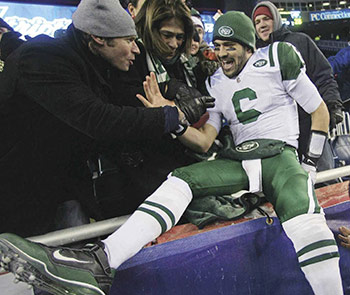 After graduating from Pomona with a degree in English, and playing for four years on the Sagehens football team, Kessler jumped right into his current field working at IMG Sports with Tom Condon, ranked by Sports Illustrated as the most influential sports agent in the country last year. Kessler, whose father has been a long-time legal representative for the NFL Players Association, had already served an internship with NBA agent Marc Fleisher while attending Pomona, traveling with 18-year old client Tony Parker to various NBA workouts (Parker has since gone on to win four NBA titles with the San Antonio Spurs and former Sagehen coach Gregg Popovich).
After graduating from Pomona with a degree in English, and playing for four years on the Sagehens football team, Kessler jumped right into his current field working at IMG Sports with Tom Condon, ranked by Sports Illustrated as the most influential sports agent in the country last year. Kessler, whose father has been a long-time legal representative for the NFL Players Association, had already served an internship with NBA agent Marc Fleisher while attending Pomona, traveling with 18-year old client Tony Parker to various NBA workouts (Parker has since gone on to win four NBA titles with the San Antonio Spurs and former Sagehen coach Gregg Popovich).
In his first two years at IMG, Kessler assisted Condon in putting together landmark contracts for Peyton Manning (seven years, $90 million) and Eli Manning (six years, $54 million), while also attending law school at the University of Texas. In his decade in the field at IMG and Athletes First, where he has worked primarily with David Dunn (No. 11 on the Sports Illustrated list of most influential agents), Kessler has been a part of negotiating contracts that total well over a billion dollars.
Most recently, Kessler helped put together a four-year, $40 million dollar deal for Super Bowl champion safety Earl Thomas of the Seattle Seahawks, making him the highest-paid player ever at his position. Kessler returned to his original home in New York City in February to see Thomas win Super Bowl XLIII at the Meadowlands, before helping to negotiate his landmark deal. Of course, Athletes First was guaranteed to be on the winning side of that Super Bowl regardless, as the firm also represents several members of the Denver Broncos, including wide receiver Wes Welker and linebacker Von Miller.
Kessler, who resides in Laguna Beach with his wife, Alison, and son, Jordan (2), has found success in a highly-competitive, big-money industry at an age when he has been younger than some of his clients. He draws some personal parallels to his playing days for Pomona-Pitzer football, when his teams went a combined 17–15 over four years despite fielding small rosters that were often significantly outweighed by their opponents.
“One lesson I learned from playing at Pomona is that you can’t judge a book by its cover,” he said. “Just about every game we played, we would lose the eyesight test. Sometimes if you just looked at the two teams in warm-ups, you’d think we’d lose by three or four touchdowns, but then the game would start and we’d win by playing harder, smarter or more fundamental football. You see the same things on the job, whether it be negotiating a contract or signing a player or issues with a client. The odds might look against you from the outside looking in, but you can accomplish your goals by digging deeper than the other guys and not being intimidated.”
He is also quick to point out that his academic experience at Pomona has been a big influence on his career. “Most of what I have learned in this business has come from on-the-job training or from my dad,” he said. “But the critical thinking and analytical skills that I use in my profession have come just as much from what I learned at Pomona, as an English major studying Henry James novels, as they have from taking law school courses in contract law.”
Although Kessler willingly made a reference to Jerry Maguire, the fictional sports agent played by Tom Cruise in the 1996 movie (best remembered for the phrase, “show me the money”), he does laugh at the way the movie portrays his line of work. “I imagine it’s the same way that real spies view James Bond movies,” he says. “People may see the eight-figure deals in the headlines, but there’s a real grind and blue-collar element to the job, which I enjoy. It takes months of negotiations and legwork to reach those deals. You can’t just walk in and say ‘give me this, I want it.’ You have to justify your rationale to the team.”
The life of a sports agent can also involve much more than negotiating the fine print of a 47-page contract, and Kessler feels that makes it even more rewarding. “One of my favorite things about this business is that you get to be involved in a lot of different charitable endeavors and other outside interests for your clients,” he says. “I’ve helped our clients raise money for sick kids, families of veterans, youth football organizations and all sorts of things. Some clients just want you involved in one specific part of their lives, and with other clients, you find yourself wearing a lot of different hats—relationship counselor, wedding planner, financial advisor, and you get to talk to them all the time.”
Kessler may also have a career-building opportunity as the primary agent representing Marqise Lee, a second-round pick of the Jacksonville Jaguars in the 2014 NFL Draft. Lee has a Hollywood-type story of overcoming a rough childhood that saw him bounce around several foster homes before becoming the Fred Biletnikoff Award winner at USC as the nation’s top wide receiver.
While his professional experience has been largely centered on the NFL, Kessler has also used his success at Athletes First to begin his own side project called K3 Tennis, which is representing Ernesto Escobedo, a 17-year-old rising star from West Covina. “I’m excited about it,” said Kessler. “It’s still in its early stages and if nothing else, it’s really fun. Some might call it a risky move to invest in something on my own, but that’s always been my personality. I traveled 3,000 miles from New York City to attend Pomona, which was a little bit risky, and I really liked my time at Pomona. When a risk like that pays off, you’re more willing to take other risks.”
His career as an athlete and as an agent has also given Kessler some philosophical perspective. Athletics is, by its nature, hyper-competitive, with a player’s or team’s value often defined by just a simple list of wins and losses. That attitude spills over into other sports-related industries as well. An agent’s success can be defined by wins and losses in contract negotiations, clients signed and dollars generated. Failures happen, and he sometimes sees colleagues who take each defeat as hard as the players on the field do.
“You have to appreciate successes,” he said. “You hear people say that they hate losing more than they like winning, and I understand that philosophy, but you have to have balance or you won’t be happy. My bad days aren’t really all that bad. On my good days, I’ve been there to see Earl Thomas win a Super Bowl. I’ve been there with Marqise Lee and his family when he was drafted, after he overcame so much adversity.”
Of course, he was also there to celebrate a big playoff win with Mark Sanchez and end up with his picture in newspapers all over the country.
“If you can’t enjoy a moment like that,” he says. “Something’s wrong.”
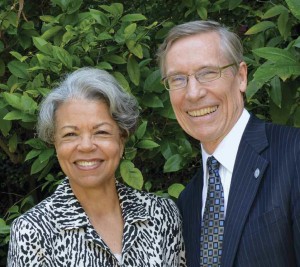


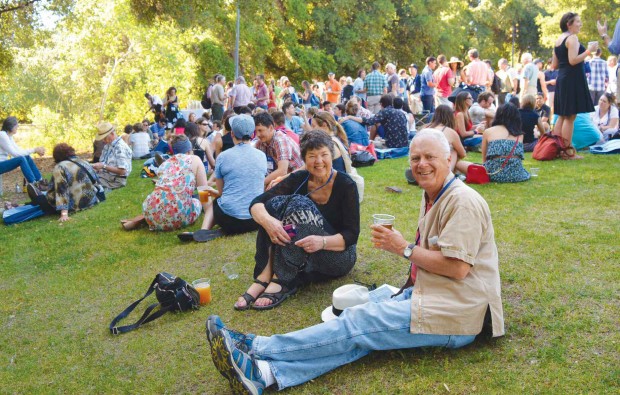
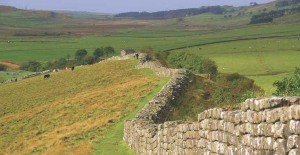

 Back at Pomona, where it all started, that yellow and black sculpture now looks fairly tame. And yet, Howe notes, “In this early work you can see the interplay of his engagement with sculpture and aspects of performance. It is a remarkably assured piece from a young artist who was working through the issues that would engage him for the rest of his career.”
Back at Pomona, where it all started, that yellow and black sculpture now looks fairly tame. And yet, Howe notes, “In this early work you can see the interplay of his engagement with sculpture and aspects of performance. It is a remarkably assured piece from a young artist who was working through the issues that would engage him for the rest of his career.”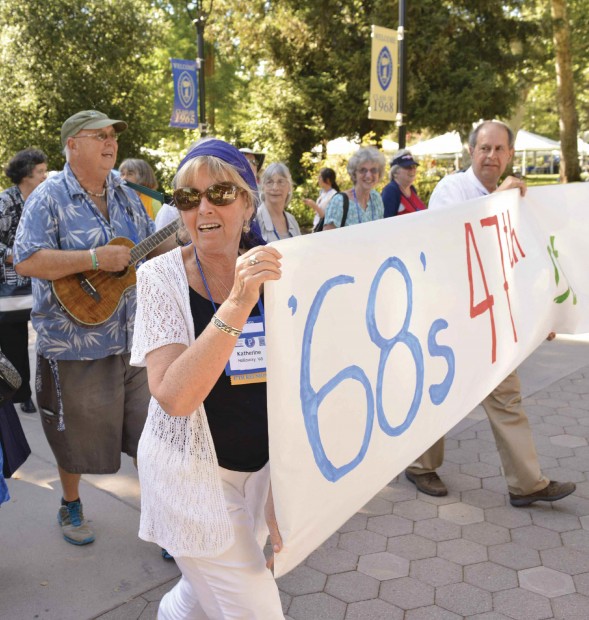
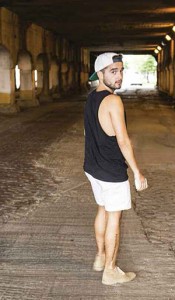 wn online store that sells unique vintage clothes. First created while he was a student at Pomona, Jonathan’s brand, STARZYK, is now based out of his hometown of Chicago. There, he’s working to make the business take root in the city and continue its growth, using creative efforts to connect with local buyers while still reaching style-minded guys across the country.
wn online store that sells unique vintage clothes. First created while he was a student at Pomona, Jonathan’s brand, STARZYK, is now based out of his hometown of Chicago. There, he’s working to make the business take root in the city and continue its growth, using creative efforts to connect with local buyers while still reaching style-minded guys across the country.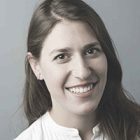
 DURING VISITS TO her hometown of Baltimore while she was a student at Pomona, Celia Neustadt ’12 started to notice some interesting shifts in the makeup of the city’s public spaces. The Inner Harbor waterfront, long seen by locals as a tourist-only enclave, had started attracting black teens from around the city looking for a place to shop and meet friends, a big change from when Neustadt herself was a Baltimore City high school student.
DURING VISITS TO her hometown of Baltimore while she was a student at Pomona, Celia Neustadt ’12 started to notice some interesting shifts in the makeup of the city’s public spaces. The Inner Harbor waterfront, long seen by locals as a tourist-only enclave, had started attracting black teens from around the city looking for a place to shop and meet friends, a big change from when Neustadt herself was a Baltimore City high school student.
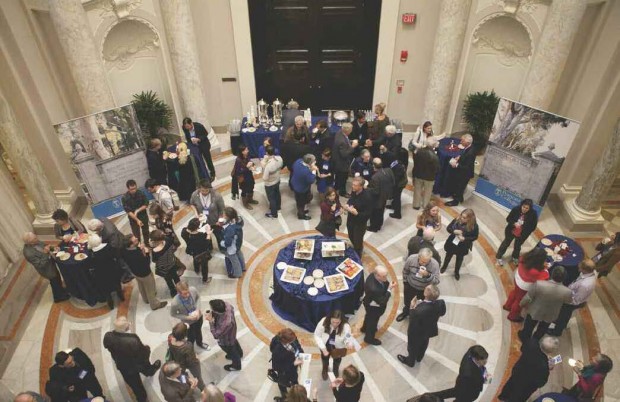


 After graduating from Pomona with a degree in English, and playing for four years on the Sagehens football team, Kessler jumped right into his current field working at IMG Sports with Tom Condon, ranked by Sports Illustrated as the most influential sports agent in the country last year. Kessler, whose father has been a long-time legal representative for the NFL Players Association, had already served an internship with NBA agent Marc Fleisher while attending Pomona, traveling with 18-year old client Tony Parker to various NBA workouts (Parker has since gone on to win four NBA titles with the San Antonio Spurs and former Sagehen coach Gregg Popovich).
After graduating from Pomona with a degree in English, and playing for four years on the Sagehens football team, Kessler jumped right into his current field working at IMG Sports with Tom Condon, ranked by Sports Illustrated as the most influential sports agent in the country last year. Kessler, whose father has been a long-time legal representative for the NFL Players Association, had already served an internship with NBA agent Marc Fleisher while attending Pomona, traveling with 18-year old client Tony Parker to various NBA workouts (Parker has since gone on to win four NBA titles with the San Antonio Spurs and former Sagehen coach Gregg Popovich).